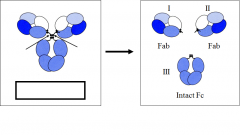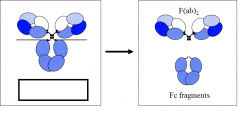![]()
![]()
![]()
Use LEFT and RIGHT arrow keys to navigate between flashcards;
Use UP and DOWN arrow keys to flip the card;
H to show hint;
A reads text to speech;
83 Cards in this Set
- Front
- Back
|
Antibodies are synthesised by |
plasma cells (lymphoid lineage) |
|
|
Antibody-antigen complexes are removed from the circulation primarily through |
phagocytosis by macrophages |
|
|
Linus Paulings model proposed that |
a preformed undifferentiated immunoprotein folded over the antigen at different locations at different haptenic groups. Immunoprotein reacted with all antigens but its conformation was different in each case |
|
|
Sir Frank MacFarlane Burnet proposed the |
clonal selection theory of acquired immunity |
|
|
After clonal deletion what happens |
clonal expansion - activated lymphocytes after selection by antigen |
|
|
antibodies are part of which family? |
glycoproteins |
|
|
antibodies are composed of |
one or more copies of a characteristic unit that form a Y shape |
|
|
define antigen |
any molecules or parts of molecules recognised by the variable antigen receptors of lymphocytes |
|
|
define epitope |
the specific region of the antigen bound by the variable region of an immunoglobulin |
|
|
define affinity |
measure of the strength of binding of an antigen by an antibody |
|
|
what type of binding is antibody to antigen? |
non-covalent and reversible |
|
|
the affinity of an antibody for an antigen is related to the ratio of |
the rates of the forward reaction for formation of the complex to back reaction for decay of the complex. |
|
|
Each Y contains 4 polypeptides |
two identical heavy chains (55kDa) Two identical light chains (22kDa) Held together by disulphide bridges and non-covalent bonds |
|
|
Fab fragment stands for |
fragment having the antigen binding site |
|
|
Fc fragment stands for |
fragment that crystalises |
|
|
The ability for an antibody to bind antigen is determnined by the |
N terminal domains (they are variable) |
|
|
There are small regions of hypervariablity within four conserved framework regions |
FR1, FR2,FR3 and FR4 |
|
|
In 3D structure the hypervariable regions form |
loops that combine together to form the principal antigen binding surfaces. Called complementarity determining regions |
|
|
Papain cleavage separates the |
Fabs from the Fc |
|

|
papain cleavage |
|

|
pepsin cleavage |
|
|
What are the 5 main classes of antibody |
IgG, IgM, IgA, IgE, IgD |
|
|
the 5 classes of antibody are divided on the basis of |
the number of Y like units and the type of heavy chain polypeptide they contain |
|
|
5 types of heavy chain |
gamma, mew, alpha, sigma and weird backwards 3 |
|
|
2 light chains |
K or lambda |
|
|
one light chain always associates with |
one heavy chain |
|
|
In humans, the IgG classes has how many sub classes |
4 these have gamma heavy chains |
|
|
In humans the IgA classes have how many sub classes? |
2 these have alpha heavy chains |
|
|
IgA is the most prevalent immunoglobulin in |
mucosal secretions |
|
|
IgA binds to |
antigens and prevents the uptake of bacteria and toxins |
|
|
Epithelial cells in teh intestine mediate the transfer of dimeric serum IgA to the intestinal lumen via |
the polymeric Ig receptor |
|
|
IgA dimer binds to the pilymeric Ig receptor via |
the J chain |
|
|
Binding of IgA induces ______ of the ploymeric Ig receptor |
transcytosis |
|
|
the IgA-pIgR complex is delivered to |
the apical surface of the epithelial cell and into the lumen |
|
|
What protects the IgA from the proteases present in mucus and anchors IgA at the desired location |
secretory component |
|
|
After opsonisation with IgA, the receptor Fcalpha/microR mediates |
the uptake of organisms by macrophages and dendritic cells |
|
|
A second receptor FcalphaRI mediates |
uptake by neutrophils |
|
|
What is a common immunodeficiency in humans? |
IgA deficiency |
|
|
what can compensate for IgA deficiency by also binding to pIgR |
IgM |
|
|
IgM opsonised organisms are phagocytosed via |
Fcalpha/microR |
|
|
Activating Fc receptors signal through |
ITAMs |
|
|
ITAM stands for |
immunoreceptor tyrosine-based activation motif |
|
|
ITAM contains |
two precisely spaced tyrosines within a consensus sequence |
|
|
What happens when ITAM is phosphorylated |
the tyrosine residues provide a binding site for one or two closely related intracellular tyrosine kinases |
|
|
Examples of tyrosine kinases |
Syk (immune cells) ZAP-70 (T cells) |
|
|
SH2 stands for |
Src Homology 2 |
|
|
what does SH2 do? |
dock onto two phosphotyrosines, activates signalling events downstream of the receptor |
|
|
pIgR stands for |
polymeric Ig receptor |
|
|
Src family tyrosine kinase is held in the |
plasma membrane by a lipid tail |
|
|
Src family tyrosine kinase does what |
phosphorylates ITAM tyrosines in the receptor Ig-alpha and Ig-Beta chains |
|
|
Phosphorylation by Src family tyrosine kinase does what |
creates a binding site for Syk |
|
|
Syk binds to |
doubly phosphorylated ITAM sequence |
|
|
What does Syk do> |
phosphorylates other signalling proteins which change behaviour of the cell |
|
|
Name the mechanisms of antibody mediated toxicity |
Antibody-dependent cell-mediated cytotoxicity (ADCC) Complement mediated cytotoxicity (CMC) |
|
|
What is antibody dependent cell mediated cytotoxicity (ADCC) |
antibody attracts cytotoxic cells by means of their Fc receptors |
|
|
What is complement mediated cytotoxicity (CDC) |
antibody binding results in fixation of complement on to the target cell. |
|
|
complement consists of |
30 serum and membrane proteins that can mediate a variety of immune reactions |
|
|
what can the complement system mediate |
triggering inflammatory responses attraction of phagocytes to sites of infection degradation of membranes or virus envelopes stimulation of antibody production |
|
|
What are the three pathways that trigger complement? |
lectin classical alternative |
|
|
what triggers the lectin pathway |
recognition of carbohydrate moieties by collectins |
|
|
what triggers the classical pathway |
antibody binding to antigen in immune complexes |
|
|
what triggers the alternative pathway |
directly at microbial cell surfaces |
|
|
what does activation of complement trigger? |
initiates a cascade of cleavages - cleaved into small (a) and big (b) fragments |
|
|
the b fragment forms what |
a subunit of the protease complex mediating the next cleavage in the pathway |
|
|
Are the early events in complement identical for every pathway |
no |
|
|
Are the late events in complement identical for every pathway |
yes |
|
|
what is the function of the early events in complement> |
generate two functionally equivilant forms of a protease, known as C3 convertase |
|
|
What does C3 convertase do? |
initiates the late events |
|
|
what is the function of the late events in complement |
produce the effector components of complement |
|
|
How does C3 convertase attach to the cell surface |
covalently |
|
|
cleavage of C3 convertase leads to |
effector activation |
|
|
what are pentraxins |
pentameric serum proteins that participate in innate immunity and activate the classical pathway of complement |
|
|
What is MASP |
mannose binding lectin associated seine protease |
|
|
Cr1 is activated by |
C1q |
|
|
Cr1 cleaves |
C1s which is activated by this |
|
|
what are the random letters associated with the lectin pathway |
MASP-2, MASP-3, C4, C4a, C4b, C2, C2a, C2b C4bC2b C3 convertase cleaves C3 |
|
|
what are the random letters associated with the classical pathway |
C1s, C1r, C1q, C4, C4a, C4b, C2, C2a, C2b C4bC2b C3 convertase cleaves C3 |
|
|
what are the random letters associated with the alternative pathway |
C3b, B, Ba, Bb C3bBb C3 convertase cleaves C3 |
|
|
Which surfactents are collectins? |
surfactent protein-A (SP-A) surfactent protein-D (SP-D) |
|
|
What do SP-A and SP-D funtion as |
oposonins that stimulate uptake by phagocytes |
|
|
SP-A and SP-D are expressed at highest levels where? |
in the lung |
|
|
Collectins structure consists of |
cysteine rich region collagen like domain neck region carbohydrate recognition domain (CRD) |
|
|
what is MBL |
mannose-binding lectin. activates the lectin pathway. |

